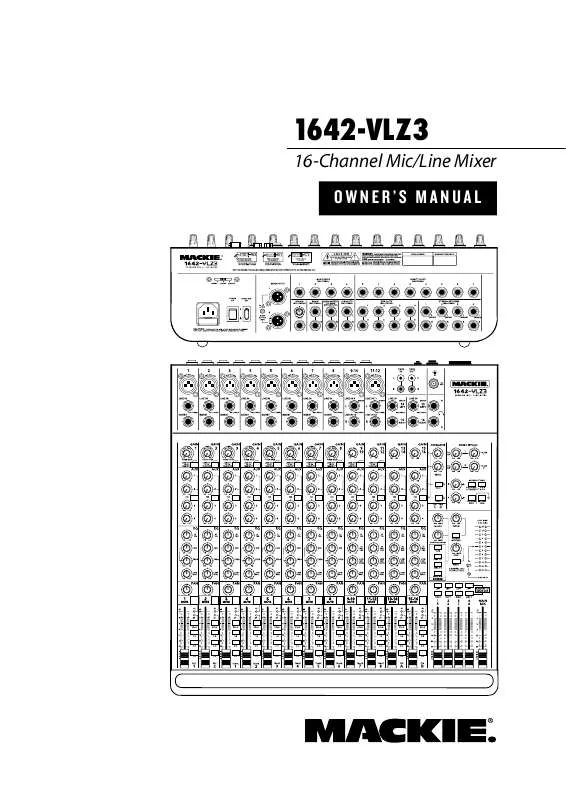Detailed instructions for use are in the User's Guide.
[. . . ] 1642-VLZ3
16-Channel Mic/Line Mixer OWNER'S MANUAL
1642-VLZ3
Important Safety Instructions
1. Donotblockanyventilationopenings. Installinaccordancewiththe manufacturer'sinstructions. Donotinstallnearanyheatsourcessuchasradiators, heatregisters, stoves, orotherapparatus(includingamplifiers)thatproduceheat. Donotdefeatthesafetypurposeofthepolarizedorgrounding-type plug. Apolarizedplughastwobladeswithonewiderthantheother. [. . . ] That may result in a startling level boost at these outputs, depending on the position of the SOLO [46] level knob. In a nutshell, soloed channels are sent to the SOURCE [42] mix, that ultimately feeds your control room, headphones, and meters. Whenever SOLO is engaged, all SOURCE selections (MAIN MIX, 12, 34 and TAPE) are defeated, to allow the soloed channel to do just that -- SOLO!
30. MUTE
Engaging a channel's MUTE switch provides the same results as turning the fader all the way down: Any channel assignment to L/R, 1-2 or 3-4 will be interrupted. All the post AUX sends will be silenced, as will the DIRECT OUT [5] signals on channels 1 through 8. And of course, that fun-loving OL (MUTE) LED [29] will commence to glow. The PRE AUX sends, channel INSERT [4] send and SOLO [27] (in LEVEL SET (PFL) mode) will continue to function during MUTE. Depending on the audio content in a channel, engaging its MUTE switch may cause a slight popping sound. This is not a problem within the mixer, and it can be avoided: Simply engage the LOW CUT [34] switch on each channel (unless its low frequency content is vitally important, such as a kick drum or bass guitar). LOW CUT eliminates subsonic debris, which causes the pop, and its effect is usually transparent.
Owner's Manual
28. 20 (SOLO) LED
An LED that does two completely different things!This saves space, but requires some explanation. First, the "20" part: Often referred to as "signal activity, " this LED will flicker in time with the signal present in that channel. It's handy for confirming that a channel is indeed active, and may also lend a clue as to what the signal is. For instance, a kick drum will cause the LED to pulse in time with the drum, and a synth pad will cause it to glow a bit more steadily. Now for the "SOLO" part: When a channel's SOLO [27] switch is engaged, this LED will glow steadily. It will also be brighter than it would be as a 20 indicator. In conjunction with the RUDE SOLO LIGHT [47], you can find a rogue SOLO switch very quickly.
31. PAN
PAN adjusts the amount of channel signal sent to the left versus the right outputs. PAN determines the fate of the L/R assignment, subgroups 12 and 34, and the SOLO [27] (in NORMAL (AFL) mode). With the PAN knob hard left, the channel signal will feed the left main mix, subgroup 1, subgroup 3 and left NORMAL (AFL) solo mode (assuming their assignment switches are engaged). With the knob hard right, the channel signal feeds the right main mix, subgroup 2, subgroup 4 and right NORMAL (AFL) solo mode. [. . . ] Here's how it works: A mono signal should be patched into the input or return jack labeled Left (MONO). The signal will be routed to both the left and right sides of the return circuit, and will show up in the center of the stereo pair of buses it's assigned to, or it can be panned with the PAN control.
RING (IN) RING (RETURN) RING (RETURN) TIP (SEND)
TIP (OUT)
FROM PROCESSOR OUTPUT TO PROCESSOR INPUT
TIP (SEND)
TO MIXER CHANNEL INSERT
Y-cord insert cable
Y-cord splitter cable
Owner's Manual
1642-VLZ3
Appendix C: Technical Information
Specifications
Main Mix Noise
(20 Hz20 kHz bandwidth, 1/4" Main out, channel gains @ unity gain, channel EQs flat, all channels assigned to Main Mix, odd channels panned left, even channels panned right. ) Main Mix fader unity, channel faders down: (90 dB Signal to Noise Ratio, ref +4 dBu) Main Mix fader unity, channel faders @ unity: 86 dBu 86. 5 dBu Low Mid Peaking Low Shelving Low Cut Filter (Ch. 912) ±15 dB @ 400 Hz ±15 dB @ 80 Hz 18 dB/octave, 3 dB @ 75 Hz
Power Consumption
50 watts
Fuse Ratings
100120 VAC 220240 VAC 1A Slo Blo, 5 x 20 mm 0. 5A Slo Blo, 5 x 20 mm
Total Harmonic Distortion (THD)
(1 kHz 35 dB gain, 20 Hz20 kHz bandwidth) Mic in to insert out: <0. 0007%
Dimensions (H x W x D) in Normal Pod Position
16. 7" x 16. 6" x 5. 2" (425 mm x 421 mm x 131 mm)
Weight
18. 2 lb (8. 3 kg) LOUD Technologies Inc. is always striving to improve our products by incorporating new and improved materials, components, and manufacturing methods. Therefore, we reserve the right to change these specifications at any time without notice. [. . . ]


